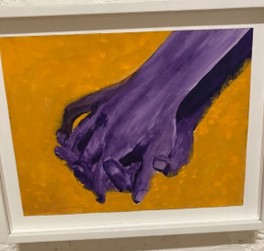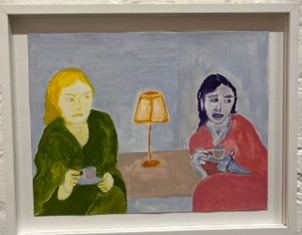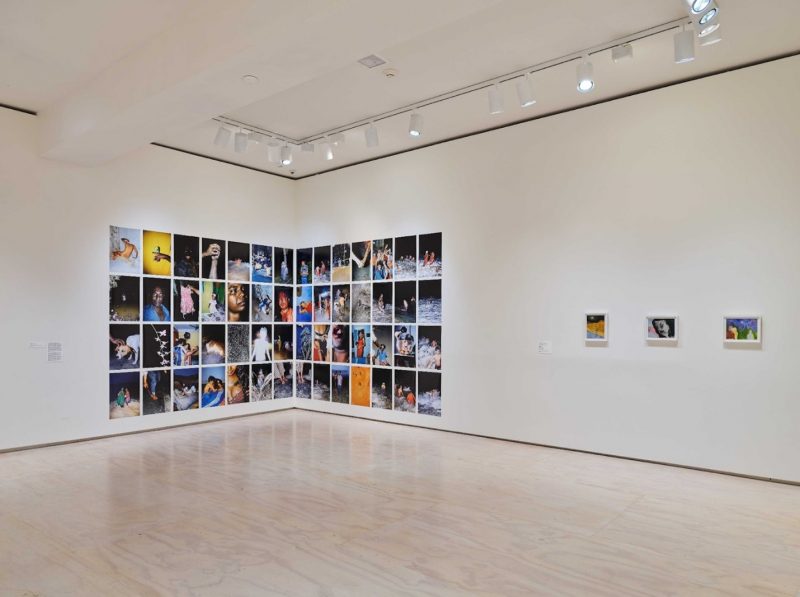A surprise turn into rooms at MoMA PS1 presenting Sohrab Hura’s oeuvre—far from art-wank—electrified our old friends’ winter break reunion trip to the museum.
The day was too good: arepas in Jackson Heights, Central Park night walk, a warm, free crib at the apartment where Dash was dog-sitting.
Now, we’ve come back together to mull over how Sohrab Hura’s work affected us that day and how he might get you going too…
A Photographer’s Light Drawings
By Ben Khadim DeMott
Sohrab Hura also paints. Hura writes on his website that he turned to painting to evoke his inner life. Photography had become too harsh a medium for self-exposure. At PS I, his pastels are collected in two rooms. In one room, Things Felt But Not Quite Expressed, Sohrab’s intimate life spills out from a medley of canvases. Scenes of social living rub up against more intimate miniatures. Hura’s pets are major characters. In Hura’s piece, 3:26 AM, his cat—a sleep paralysis cutie—glares at us. In another work, two tiny fingers pluck at a man’s leg hairs. What’s the deal?, you wonder. Hura’s funny caption clears up the mystery: Delhi to New York, all sixteen hours of it.
Room 2 has a set of Hura’s smaller highlights. Pieces that could be set anywhere in the world stand out against The Coast—photographs taken at a Tamil Nadu religious festival. At first, I assumed the swatches of images in the room’s two corners were made by different artists. Yet Hura’s color palette syncs up the two projects. The paintings revel in green, yellow, purple and orange worlds. (The photographs here are all about color as well: googly eyes pop out of an orange curry and bright red fake blood pours down, covering a man’s face.)
Hura’s paintings aren’t meant to seem masterly. He gets lost, like a kid would, in the material hues. His paintings, though, aren’t just exercises that bow to Picasso’s dictum: “It took me four years to paint like Raphael, but a lifetime to paint like a child.” Hura hasn’t sacrificed his mature photographer’s eye or instinctive sensitivity. Things Felt’s diary entries, in Room 1, can only appeal for so long. Room 2’s set slips art therapy, reaching for universals.


Capturing the Bittersweet
By Dashiel Tao Harris
When I entered the last room of the exhibit, I was drawn in by sounds that seemed eerie yet whimsical, oscillating from the ear-tingling blare that follows the thud of a microphone to soft-tones like a soundtrack to Spring rain. Trying to make sense of the noises, I turned left, expecting a screen at eye-level. But my view dropped down to a flat screen leaning against a corner of the room. Once again, I found myself trying to balance a sense of discombobulation and fascination. The uneasy music accompanied unobvious images documenting the relationship between a woman and her pet dog.
The bluntness of Hura’s photographs makes it hard to look away. (It surely made me stay longer than I had expected at his exhibit.) His way of addressing the relationship between his paranoid schizophrenic mother and her dying dog kept me trying to make sense of his ambiguities. He calls this sequence of sounds and images, “Bittersweet.” It’s an apt title as Hura refuses to choose between bitter and sweet. His aesthetic is plain yet revelatory; it looks and feels like he has shined headlights on the darkness of his mother’s home (and self). His images are honest, showing the mess of her room with the paint peeling off the walls, and the slow demise of her pet. Yet despite the bitter realism, Hura also conveys sweetness. It’s there in the care shown by the mother to the dog (but also by Hura to his mother).
I remember the image of Hura’s mother carefully wrapping the dog’s head in a scarf as if it were her sick child. Or when mother and dog lay in bed together with their heads close underneath a blanket, like they’re friends sharing secrets at a sleepover. And through the sequencing of Hura’s portraits of his mom and her pet, I began to find similarities in their facial expressions, deepening their connection. Hura seems to take an “objective” documentary approach, but his presence still lingers. One example stands out. There’s a photo of Hura’s mother taking a photo. In the background, a mirror reflects the flash of Hura’s own camera. This image is followed by one depicting Hura and the dog sitting on the bed with open smiles, beloveds seen from a mother’s perspective.
The wonder of her caring (and Hura’s) deepened for me as I took in her Paranoid Schizophrenia diagnosis. While there aren’t many words spoken in this film, early on Hura tells how fewer and fewer people came to his mother’s house as she became more distrustful. Yet Hura confirms he still felt his mother’s love for him. That feeling is evident in the way she continues to welcome Hura into her home and intimate life. Hura reciprocates his mother’s love and trust by the humane, nonjudgmental way he renders the truth about her mental illness. Just like the sounds of the piece, “Bittersweet’s” images oscillate through varying feelings, forms, and tones. Hura shows us the highs and lows of his mother’s mental illness. And he doesn’t shy away from sharing the decline of his mother’s pet and how her despair affected his family.
Hura’s approach to mental illness (and mortality) seems profound, because he catches details of feelings as they come and go. He grasps that nobody’s life is defined by one moment or thing while underscoring the love that makes it possible…
You Are Going in the Sauce
By Malachy Guzman
I gravitated to The Coast—Hura’s photography, short stories, and film of the Indian coastline—right away. This section of his larger survey exhibition, Mother, initially presents itself as a grid of images wrapping around the corner of the room. 
Image from the PS1 MoMA https://www.momaps1.org/en/programs/460-sohrab-hura
All the prints come from the book version of The Coast, on display to the left of the wall spread (out of frame). The book punctuates the photographs with twelve retellings of the same short story, but it took me a few minutes to even notice the book. I was first drawn to the bizarreness of the images. Immediately visible are Hura’s absurd sense of humor (how did the face in the bottom row get in the orange sauce?) and his attraction to horror. In the second row, one image shows a man winding up to beat another with a stone, the next image is a closeup portrait of a man soaked in viscous blood, and two images later, a boy (this time) winds to stone another boy. These images are clearly constructed, not documents of real violence. The boy about to be beaten with a rock, for example, doesn’t seem too concerned about it.
Although we’re sure the violence is simulated, the sequence still feels horrific in an uncanny way. The brief narratives Hura presents in his constructed images mostly lack explicit context, and the wide range of narratives on the wall—couple in bed, magnified eye, playing in the surf, bandaged man with the bloody machete—make it even less clear what is going on. Whether gory or joyful, Hura’s staged images are typically sharp. The ones that are more abstracted—a ghostly over- and double-exposed man, a long-exposure of the man by the fire, sparks in the air—are less realistic in their technical execution, but their lack of explicit narrative somehow more directly reflects the ominous feeling Hura conveys without being contrived.
All this is complicated by the displayed book, where the images are paired and repeated in a way that strips context and muddies reality even further. Hura doesn’t intend to explain himself either; the first short story I mentioned, which opens the book, is at once gory and unreal, romantic and self-conscious. “Snap! went my neck before the rough sand ripped the skin off my back as I was dragged back onto the beach,” it begins. “I watch the translucent sky with dimming stars as I lay back afloat and wait for the next wave to carry me further away in its embrace,” it ends. The book follows (roughly) the sequence on the wall, opening with two images that make the title of a separate work, The Lost Head and the Bird. What does this have to do with the visceral story of being smashed against the surf we just read!? The book is full of allusions and uneasy tension, which I couldn’t resolve until reading Hura’s own thoughts. More on that shortly.
We walked into an adjoining room screening the film The Coast (2020), produced a year after the book, The Coast. Lying on beanbags, the three of us watched the 17-minute film with a mixture of awe and fear. A bit more geographically focused than its book counterpart, the film centers on a religious festival in a village in the Indian state of Tamil Nadu. Most of its runtime is devoted to slow motion scenes of people playing and crashing through the surf on a beach at night. On his website, Hura comments on the film: “The physical coastline becomes a metaphor for a ruptured piece of skin barely holding together a volatile state of being ready to explode.” Not exactly straightforward, but now we have a sense of the intention behind the unease conveyed in the photos. As you might expect, the beach scenes are both playful and unsettling as individuals slip into the black water, some coming back, others gone from the screen for good…
In an interview posted at Magnum—the renowned photo agency where Sohrab Hura is a full member—we get a window into the political reality Hura has been engaging with, urgently if obliquely, this whole time. He first describes the festival, telling the interviewer that people there masquerade as specific characters relating to their prayers (contextualizing some images from the sequence in the first room), later washing themselves off in the sea as though they are being cleansed of their sins. From this image, Hura elaborates…
“In a way we are all wearing masks. I looked at how the current climate of violence is defined by those masks that dominate. Coincidently, The Modi wave that brought a change in the political and social regime five years ago also manifested itself in a sea of masks with the face of the current prime minister on them that were swirling around us. This stepping into the sea is a sort of a new beginning for the people, a sort of a shedding of that mask. In its metaphors, the book ends with a little more relief—one could even say hope—compared to the film.”[1]
I’m still not sure exactly how to understand the tension in Sohrab Hura’s vision. My rambling analysis leads me to one thought: I now must learn everything about Hura’s work, past, present, and future to better comprehend what he has shown us. I also need to know who produced the music for the film! On view at the PS1 MoMA through February 17, I’d recommend you go see “The Coast” and the rest of Hura’s survey exhibition, “Mother.” If, like me, you were unfamiliar with his work, you’ll be just as intrigued by Hura’s artful, if challenging, political and personal investigations.
Note
1 https://www.magnumphotos.com/theory-and-practice/the-coast-sohrab-hura/